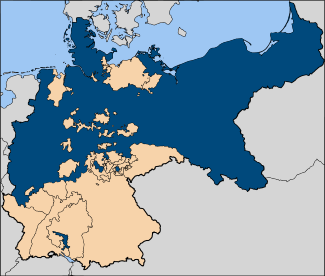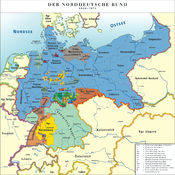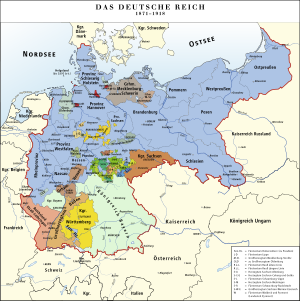Kingdom of Prussia
|
|||||||||||||||||||||||||||||||||||||||||||||||||||||||||||||||||||||||||||||||||||||||||||||||||||||||||||||||||
The Kingdom of Prussia (German: Königreich Preußen) was a German kingdom from 1701 to 1918. Until the defeat of Germany in World War I, it comprised almost two-thirds of the area of the German Empire. It took its name from the territory of Prussia, although its power base was Brandenburg.
Contents |
History
Establishment
Since 1618, the Electorate of Brandenburg and the Duchy of Prussia were ruled in personal union by the House of Hohenzollern ("Brandenburg-Prussia"). In the course of the Second Northern War, the Treaty of Labiau and the Treaty of Wehlau-Bromberg granted the Hohenzollern sovereignty in the Prussian duchy. Thus, Frederick III (I) was able to style himself King in Prussia in 1701.
1701-1740: The young Kingdom
The new Kingdom of Prussia was very poor—still having not fully recovered from the devastation of the Thirty Years’ War—and its territory was scattered across over 1,200 km (750 mi): from the lands of the Duchy of Prussia on the south-east coast of the Baltic Sea, to the Hohenzollern heartland of Brandenburg, to the exclaves of Cleves, Mark and Ravensberg in the Rhineland. In 1708, approximately one third of the population of the Duchy of Prussia fell victim to the bubonic plague.[3] The plague reached Prenzlau in August 1710, but eventually receded before it could reach the capital Berlin, which was only 80 km (50 mi) away.
Sweden's defeat by Russia, Saxony, Poland, Denmark–Norway, Hanover, and Prussia in the Great Northern War (1700–1721) marked the end of significant Swedish power on the southern shores of the Baltic Sea. In the course of the Pomeranian campaign and by the Prusso-Swedish Treaty of Stockholm (January 1720), Prussia gained southern Swedish Pomerania with Stettin (Szczecin). Already in 1529, the Hohenzollerns of Brandenburg had secured the reversion to the Duchy of Pomerania after a series of conflicts, and acquired its eastern part following the Peace of Westphalia.
During this time, the trends set in motion by the Great Elector reached their culmination, as the Junkers, the landed aristocracy, were welded to the Prussian Army. This era also saw the rise of compulsory education in Germany[4]King Frederick William I inaugurated the Prussian compulsory system in 1717.[4]
1740-1760: The Silesian Wars
In 1740, King Frederick II (Frederick the Great) came to the throne. Using the pretext of a 1537 treaty (vetoed by Emperor Ferdinand I) by which parts of Silesia were to pass to Brandenburg after the extinction of its ruling Piast dynasty, Frederick invaded Silesia, thereby beginning the War of the Austrian Succession. After rapidly occupying Silesia, Frederick offered to protect Archduchess Maria Theresa of Austria if the province were turned over to him. The offer was rejected, but Austria faced several other opponents, and Frederick was eventually able to gain formal cession with the Treaty of Berlin in 1742.
To the surprise of many, Austria managed to renew the war successfully. In 1744 Frederick invaded again to forestall reprisals and to claim, this time, the province of Bohemia. He failed, but French pressure on Austria's ally Great Britain led to a series of treaties and compromises, culminating in the 1748 Treaty of Aix-la-Chapelle that restored peace and left Prussia in possession of most of Silesia.
Humiliated by the cession of Silesia, Austria worked to secure an alliance with France and Russia (the "Diplomatic Revolution"), while Prussia drifted into Great Britain's camp forming the Anglo-Prussian Alliance. When Frederick preemptively invaded Saxony and Bohemia over the course of a few months in 1756-1757, he initiated the Seven Years' War which might also be considered the first world war since it was fought in the three continents (France and Great Britain's colonies).
This war was a desperate struggle for the Prussian Army, and the fact that it managed to fight much of Europe to a draw bears witness to Frederick's military skills. Facing Austria, Russia, France, and Sweden simultaneously, and with only Hanover (and the non-continental British) as notable allies, Frederick managed to prevent serious invasion until October 1760, when the Russian army briefly occupied Berlin and Königsberg. The situation became progressively grimmer, however, until the death of Empress Elizabeth of Russia (the miracle of the House of Brandenburg). The accession of the Prussophile Peter III relieved the pressure on the eastern front. Sweden also exited the war at about the same time.
Defeating the Austrian army at the Battle of Burkersdorf and relying on continuing British success against France in the war's colonial theatres, Prussia was finally able to force a status quo ante bellum on the continent. This result confirmed Prussia's major role within the German states and established the country as a European great power. Frederick, appalled by the near-defeat of Prussia, lived out his days as a much more peaceable ruler.
1772, 1793, 1795: Partitions of Polish-Lithuanian Commonwealth
  History of Brandenburg and Prussia |
|||
| Northern March pre-12th century |
Old Prussians pre-13th century |
||
| Margraviate of Brandenburg 1157–1618 (1806) |
Ordensstaat 1224–1525 |
||
| Duchy of Prussia 1525–1618 |
Royal (Polish) Prussia 1466–1772 |
||
| Brandenburg-Prussia 1618–1701 |
|||
| Kingdom in Prussia 1701–1772 |
|||
| Kingdom of Prussia 1772–1918 |
|||
| Free State of Prussia 1918–1947 |
|||
| Brandenburg 1947–1952 / 1990–present |
|||
To the east and south of Prussia, the Polish-Lithuanian Commonwealth had gradually weakened during the 18th century. Alarmed by increasing Russian influences in Polish affairs and by a possible expansion of the Russian Empire, Frederick was instrumental in initiating the first of the Partitions of Poland between Russia, Prussia, and Austria in 1772 to maintain a balance of power. The Kingdom of Prussia annexed most of the Polish province of Royal Prussia, including Warmia; the annexed land was organized the following year into the Province of West Prussia. The new territory connected the Province of East Prussia (the territory previously known as the Duchy of Prussia) with the Province of Pomerania, uniting the kingdom's eastern territories.
After Frederick died in 1786, his nephew Fredrick William II continued the partitions, gaining a large part of western Poland in 1793.
In 1795, the Kingdom of Poland ceased to exist and a large area (including Warsaw) to the south of East Prussia became part of Prussia. These new territories were organized into the Provinces of New Silesia, South Prussia, and New East Prussia.
1801-1815: Napoleonic Wars
In the Treaty of Basel (1795), ending the War of the First Coalition against France the First French Republic and Prussia had stipulated, that the latter would ensure the Holy Roman Empire's neutrality in all the latter's territories north the demarcation line of the river Main, including the British continental dominions of the Electorate of Hanover and the Duchies of Bremen-Verden. To this end, Hanover (including Bremen-Verden) also had to provide troops for the so-called demarcation army maintaining this state of armed neutrality.
In the course of the War of the Second Coalition against France (1799–1802) Napoléon Bonaparte urged Prussia to occupy the continental British dominions. In 1801 24,000 Prussian soldiers invaded, surprising Hanover, which surrendered without a fight. In April 1801 the Prussian troops arrived in Bremen-Verden's capital Stade and stayed there until October of the same year. The United Kingdom of Great Britain and Ireland first ignored Prussia's hostility, but when it joined the pro-French coalition of armed 'neutral' powers such as Denmark-Norway and Russia, Britain started to capture Prussian sea vessels. After the Battle of Copenhagen (1801) the coalition fell apart and Prussia withdrew again its troops.
At Napoléon's instigation Prussia recaptured British Hanover and Bremen-Verden in early 1806. On August 6, the same year the Holy Roman Empire was dissolved as a result of Napoléon's victories over Austria. The title of Kurfürst (Prince-elector) of Brandenburg became meaningless, and was dropped.[5] Before this time, the Hohenzollern sovereign had held many titles and crowns, from Supreme Governor of the Protestant Churches (summus episcopus) to King, Elector, Grand Duke, Duke for the various regions and realms under his rule. After 1806, Frederick William III simply was King of Prussia and summus episcopus.
But when Prussia, after it turned against the French Empire, was defeated in the Battle of Jena-Auerstedt (November 11, 1806), King Frederick William III was forced to temporarily flee to remote Memel. After the Treaties of Tilsit in 1807, Prussia lost about half of its territory, including the land gained from the Second and Third Partitions of Poland (which now fell to the Duchy of Warsaw) and all land west of the Elbe River. France recaptured Prussian-occupied Hanover, including Bremen-Verden. The remainder of the kingdom was occupied by French troops (at Prussia’s expense) and the king was obliged to make an alliance with France and join the Continental System.
After the defeat of Napoleon in Russia, Prussia quit the alliance and took part in the Sixth Coalition during the "Wars of Liberation" (Befreiungskriege) against the French occupation. Prussian troops under Marshal Gebhard Leberecht von Blücher contributed crucially in the Battle of Waterloo of 1815 to the final victory over Napoleon.
1815: Prussia after Napoleon
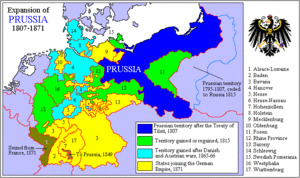
Prussia’s reward for its part in France's defeat came at the Congress of Vienna, where Prussia was granted most of its lost territories and considerably more, including 40% of the Kingdom of Saxony and much of the Rhineland. Much of the territory annexed in the Third Partition of Poland was granted to Congress Poland under Russian rule.
With these Prussian gains in territory, the kingdom was reorganised into ten provinces. Most of the kingdom, aside from the Provinces of East Prussia, West Prussia, and Posen, became part of the new German Confederation, a confederacy of 39 sovereign states replacing the defunct Holy Roman Empire.
Frederick William III submitted Prussia to a number of administrative reforms, among others reorganising the government by way of ministries, which remained formative for the following hundred years.
As to religion Calvinist (Reformed) Frederick William III as Supreme Governor of the Protestant Churches asserted his long-cherished project (started in 1798) to unite the Lutheran and the Reformed Church in Prussia in 1817 (Prussian Union). The Calvinist minority, strongly supported by its co-religionist Frederick William III, and the partially reluctant Lutheran majority formed the united Protestant Evangelical Church in Prussia, however, ensuing quarrels causing a permanent schism among the Lutherans into united and Old Lutherans by 1830.
As a consequence of the Revolutions of 1848, the Principalities of Hohenzollern-Sigmaringen and Hohenzollern-Hechingen (ruled by a Catholic cadet branch of the House of Hohenzollern) were annexed by Prussia in 1850, later united as Province of Hohenzollern.
1848–1871: The German wars of unification
For the following half-century after the Congress of Vienna, there was a conflict of ideals within the German Confederation between the formation of a single German nation and the conservation of the current collection of smaller German states and kingdoms. The creation of the German Customs Union (Zollverein) in 1834, which excluded the Austrian Empire, increased Prussian influence over the member states. As a consequence of the Revolutions of 1848, King Frederick William IV was offered the crown of a united Germany by the Frankfurt Parliament. Frederick William refused the offer on the grounds that revolutionary assemblies could not grant royal titles. But there were two other reasons why he refused: to do so would have done little to end the internal power struggle between Austria and Prussia, and all Prussian kings (up to and including William I) feared that the formation of a German Empire would mean the end of Prussia’s independence within the German states.
In 1848, actions taken by Denmark towards the Duchies of Schleswig and Holstein led to the First War of Schleswig (1848–51) between Denmark and the German Confederation. Denmark was defeated, but Prussia was embarrassingly forced to allow Denmark to keep both duchies.
Frederick William issued Prussia's first constitution by his own authority in 1850. This document—moderate by the standards of the time but conservative by today's standards—provided for a two-house parliament. The lower house, or Landtag was elected by all taxpayers, who were divided into three classes whose votes were weighted according to the amount of taxes paid. Women and those who paid no taxes had no vote. This allowed just over one-third of the voters to choose 85% of the legislature, all but assuring dominance by the more well-to-do men of the population. The upper house, which was later renamed the Herrenhaus ("House of Lords"), was appointed by the king. He retained full executive authority and ministers were responsible only to him (indeed, as late as 1910, Prussian kings believed that they ruled by divine right). As a result, the grip of the landowning classes, the Junkers, remained unbroken, especially in the eastern provinces.
Frederick William suffered a stroke in 1857, and his younger brother, Crown Prince Wilhelm, became regent. Wilhelm pursued a considerably more moderate course, and gained enough power that by Frederick William's death in 1861, he was able to become king in his own right as William I. However, shortly after gaining the throne in his own right, he faced a dispute with his parliament over the size of the army. The parliament, dominated by the liberals, balked at William's desire to increase the number of regiments and withheld approval of the budget to pay for its cost. A deadlock ensued, and William seriously considered abdicating in favour of his son, Crown Prince Frederick William. He was, however, persuaded to appoint as prime minister Otto von Bismarck, his ambassador to France. Bismarck took office on September 23, 1862.
Although Bismarck had a reputation as an unyielding conservative, he was initially inclined to seek a compromise over the budget issue. However, William refused to consider it; he viewed defense issues as the crown's personal province. Forced into a policy of confrontation, Bismarck came up with a novel theory. Under the constitution, the king and the parliament were responsible for agreeing on the budget. Bismarck argued that since they had failed to come to an agreement, there was a "hole" in the constitution, and the government had to continue to collect taxes and disburse funds in accordance with the old budget in order to keep functioning. The government thus operated without a new budget from 1862 to 1866, allowing Bismarck to implement William's military reforms.
The liberals violently denounced Bismarck as a violator of the law. However, Bismarck's real plan was an accommodation with liberalism. He had come to believe that German unification was inevitable, but that the conservative forces had to take the lead in the drive toward creating a unified nation in order to keep from being eclipsed. He also believed that the middle-class liberals wanted a unified Germany more than they wanted to break the grip of the traditional forces over society. He thus embarked on a drive to create a united Germany under Prussian leadership, and guided Prussia through three wars which ultimately achieved this goal.
The first of these wars was the Second War of Schleswig (1864), which Prussia initiated and succeeded in gaining the assistance of Austria. Denmark was soundly defeated and surrendered both Schleswig and Holstein, to Prussia and Austria respectively.
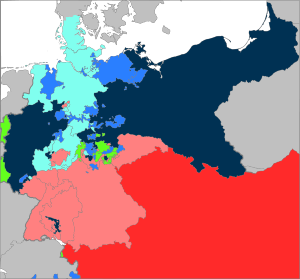
Prussia Prussian allies: Italy and 14 German states[6] Austria-Hungary Austrian allies: 11 German states[7] Neutral states: Liechtenstein, Limburg, Luxembourg, Reuss-Schleiz, Saxe-Weimar-Eisenach, Schwarzburg-Rudolstadt Prussian acquisitions: Hanover, Schleswig-Holstein, Hessian Hinterland, Hesse-Kassel, Nassau and Frankfurt
The divided administration of Schleswig and Holstein then became the trigger for the Austro-Prussian War (1866 – also known as the Seven Weeks’ War), where Prussia, allied with the Kingdom of Italy and various northern German states, declared war on the Austrian Empire. The Austrian-led coalition was crushed, and Prussia annexed four of its smaller allies--the Kingdom of Hanover, the Electorate of Hesse, the Duchy of Nassau and the Free City of Frankfurt. Prussia also annexed Schleswig and Holstein, and also effectively annexed Saxe-Lauenburg by forcing it into a personal union with Prussia (which was turned into a full union in 1876). King William initially wanted to take territory from Austria itself, but Bismarck persuaded him to abandon the idea. While Bismarck wanted Austria to play no future role in German affairs, he still saw that Austria could be a valuable future ally.
With these gains in territory, the Prussian possessions in the Rhineland and Westphalia were connected to the rest of the kingdom for the first time. Counting the de facto annexation of Saxe-Lauenburg, Prussia now stretched uninterrupted across the northern two-thirds of Germany. It would remain at this size until the overthrow of the monarchy in 1918.
Bismarck used this opportunity to end the budget dispute with parliament. He proposed a bill of indemnity granting him retroactive approval for governing without a legal budget. He guessed, correctly as it turned out, that this would lead to a split between his liberal adversaries. While some of them argued that there could be no compromise with the principle of constitutional government, most of the liberals decided to support the bill in hopes of winning more freedom in the future.
The German Confederation was dissolved as part of the war. In its place, Prussia cajoled the 21 states north of the Main into forming the North German Confederation in 1867. Prussia was the dominant state in this new grouping, with four-fifths of its territory and population. Its near-total control was cemented in a constitution written by Bismarck. Executive power was vested in a president--an office vested in the Prussian crown according to hereditary right. He was assisted by a chancellor responsible only to him. There was also a two-house parliament. The lower house, or Reichstag (Diet), was elected by universal male suffrage. The upper house, or Bundesrat (Federal Council) was appointed by the state governments. The Bundesrat was, in practice, the stronger chamber. Prussia had 17 of 43 votes, and could easily control proceedings through alliances with the other states. For all intents and purposes, the new grouping was dominated by Bismarck. He served as his own foreign minister for virtually his entire tenure as prime minister of Prussia, and in that capacity was able to instruct the Prussian delegates to the Bundesrat.
The southern German states (except Austria) were forced to accept military alliances with Prussia, and Prussia began steps to merge them with the North German Confederation. Bismarck’s planned Kleindeutschland unification of Germany had come considerably closer to realisation.
The final act was the Franco-Prussian War (1870), where Bismarck maneuvered Emperor Napoleon III of France into declaring war on Prussia. Activating the German alliances put in place after the Austro-Prussian War, the German states came together and swiftly defeated France. Even before then, Bismarck was able to complete the work of unifying Germany under Prussian leadership. The patriotic fervour aroused by the war with France was too much for the remaining opponents of a unified nation to overcome, and on 18 January 1871 (the 170th anniversary of the coronation of the first Prussian king, Frederick I), the German Empire was proclaimed in the Hall of Mirrors at Versailles outside of Paris, while the French capital was still under siege. King William became the first emperor of a unified Germany.
1871-1918: Prussia’s peak and fall
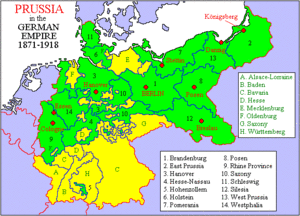
Bismarck's new empire was the most powerful state on the Continent. Prussia's dominance over the new empire was almost as absolute as it was with the North German Confederation. It included two-thirds of the empire's territory and three-fifths of its population. The imperial crown was a hereditary office of the House of Hohenzollern. Prussia also had a large plurality of seats in the Bundesrat, and as before could control the proceedings with the support of its allies in the secondary states.
However, the seeds for future problems lay in a gross disparity between the imperial and Prussian systems. The empire had a system of universal suffrage for all men over 25. However, Prussia retained its restrictive three-class voting system, in which the well-to-do had 17.5 times the voting power of the rest of the population. Since the imperial chancellor was, except for two periods (January-November 1873 and 1892-94) also prime minister of Prussia, this meant that for most of the empire's existence, the king/emperor and prime minister/chancellor had to seek majorities from legislatures elected by two completely different franchises.
At the time of the empire's creation, both Prussia and Germany were roughly two-thirds rural. Within 20 years, the situation was reversed; the cities and towns accounted for two-thirds of the population. However, in both the kingdom and the empire, the constituencies were never redrawn to reflect the growing population and influence of the cities and towns. This meant that rural areas were grossly overrepresented from the 1890s onward.
Bismarck realised that the rest of Europe was sceptical of his powerful new Reich, and turned his attention to preserving peace with such acts as the Congress of Berlin. The new German Empire improved its already-strong relations with Britain. The ties between London and Berlin had already been sealed with a golden braid in 1858, when Crown Prince Frederick William of Prussia married Princess Victoria of Britain.
William I died in 1888, and the Crown Prince succeeded to the throne as Frederick III. The new emperor, a decided Anglophile, planned to transform Prussia and the empire into a more liberal and democratic monarchy on the British model. However, he died after only 99 days on the throne and was succeeded by his 29-year old son, William II. As a boy, William had rebelled against his parents' efforts to mould him as a liberal, and had become thoroughly Prussianised under Bismarck's tutelage. The new Kaiser rapidly soured relations with the British and Russian royal families (despite being closely related to them), becoming their rival and ultimately their enemy.
William II ousted Bismarck from office in 1890 and began a campaign of militarization and adventurism in foreign policy that eventually led Germany into isolation. A gross misjudgement of the Austro-Hungarian conflict with Serbia by the Kaiser, who left for holidays, and hasty mobilization plans of several nations led to the disaster of World War I (1914–1918). As the price of their withdrawal from the war, the Bolsheviks conceded large regions of the western Russian Empire, some of which bordered Prussia, to German control in the Treaty of Brest-Litovsk (1918). German control of these territories only lasted for a few months, however, because of the defeat of German military forces and the German Revolution – which led to the Kaiser’s abdication and exile.
The post-war Treaty of Versailles, which held Germany solely responsible for the war, was signed in Versailles' Hall of Mirrors, where the German Empire had been created. With the abdication of Wilhelm II in 1918, the Kingdom of Prussia was dissolved and replaced with the Free State of Prussia.
Politics

The Kingdom of Prussia was an absolute monarchy until the Revolutions of 1848 in the German states, after which Prussia became a constitutional monarchy and Adolf Heinrich von Arnim-Boitzenburg was elected as Prussia's first prime minister. Following Prussia's first constitution, a two-house parliament was formed. The lower house, or Landtag was elected by all taxpayers, who were divided into three classes according to the amount of taxes paid. This allowed just over 25% of the voters to choose 85% of the legislature, all but assuring dominance by the more well-to-do elements of the population. The upper house, which was later renamed the Prussian House of Lords, was appointed by the king. He retained full executive authority and ministers were responsible only to him. As a result, the grip of the landowning classes, the Junkers, remained unbroken, especially in the eastern provinces. Prussian Secret Police, formed in response to the Revolutions of 1848 in the German states, aided the conservative government.
Subdivisions of Prussia
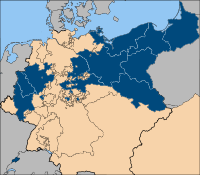
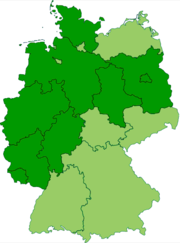
The original core regions of the Kingdom of Prussia were the Margraviate of Brandenburg and the Duchy of Prussia which together formed Brandenburg-Prussia. A Further Pomeranian province had been held by Prussia since 1653. Combined with Swedish Pomerania, gained from Sweden in 1720 and 1815, this region formed the Province of Pomerania. Prussian gains in the Silesian Wars led to the formation of the Province of Silesia in 1740.
After the First Partition of Poland in 1772, the newly-annexed Royal Prussia and Warmia became the Province of West Prussia, while the Duchy of Prussia (along with part of Warmia) became the Province of East Prussia. Other annexations along the Noteć (Netze) River became the Netze District. Following the second and third partitions (1793-1795), the new Prussian annexations became the Provinces of New Silesia, South Prussia, and New East Prussia, with the Netze District redivided between West and South Prussia. These three provinces were ultimately lost to Congress Poland after the Congress of Vienna in 1815, except for the western part of South Prussia, which would form part of the Grand Duchy of Posen.
Following the major western gains made by Prussia after the Vienna Congress, a total of ten provinces were established, each one subdivided further into smaller administrative regions known as Regierungsbezirke. The provinces were:
- Province of Brandenburg
- Province of East Prussia
- Province of Jülich-Cleves-Berg
- Grand Duchy of the Lower Rhine
- Province of Pomerania
- Grand Duchy of Posen (authonomus, outside of German Confederation)
- Province of Saxony
- Province of Silesia
- Province of West Prussia
- Province of Westphalia
In 1822, the provinces of Jülich-Cleves-Berg and the Lower Rhine were merged to form the Rhine Province. In 1829, the Provinces of East and West Prussia merged to form the Province of Prussia, but the separate provinces were reformed in 1878. The principalities of Hohenzollern-Sigmaringen and Hohenzollern-Hechingen were annexed in 1850 to form the Province of Hohenzollern.
After Prussia's victory in the 1866 Austro-Prussian War, territories annexed by Prussia were reorganised into three new provinces: Hanover, Hesse-Nassau and Schleswig-Holstein.
See also
- List of Kings of Prussia
- Prussian Army
- Free State of Prussia
- Prussian Crown Jewels
- Prussian virtues
- History of Germany
- Kreis in Prussia
References
- ↑ 1.0 1.1 "Königreich Preußen (1701-1918)" (in German). http://www.deutsche-schutzgebiete.de/koenigreich_preussen.htm. Retrieved 2007-05-02.
- ↑ "German Empire: administrative subdivision and municipalities, 1900 to 1910" (in German). http://www.gemeindeverzeichnis.de/gem1900/gem1900.htm?gem1900_2.htm. Retrieved 2007-05-02.
- ↑ Walker, Mack, The Salzburg transaction: expulsion and redemption in eighteenth-century Germany, (Cornell University Press, 1992), 74.
- ↑ 4.0 4.1 Rothbard, Murray N. (1999). Education: Free & Compulsory. Auburn, Alabama: The Ludwig von Mises Institute. p. 24–27. ISBN 0945466-22-6.
- ↑ When the Holy Roman Empire was dissolved in 1806, the function of prince-electors electing its emperors had lapsed.
- ↑ Prussia allies in the Austro-Prussian War were: Anhalt, Bremen, Brunswick, Lauenburg, Lippe-Detmold, Lübeck, Hamburg, Mecklenburg-Schwerin, Mecklenburg-Strelitz, Oldenburg, Saxe-Altenburg, Saxe-Coburg and Gotha, Schwarzburg-Sondershausen, Waldeck-Pyrmont
- ↑ Austrian allies in the Austro-Prussian War were: Baden, Bavaria, Hanover, Hesse-Darmstadt, Hesse-Kassel (or Hesse-Cassel), Nassau, Reuss-Greiz, Saxe-Meiningen, Saxony, Schaumburg-Lippe, Württemberg
|
|||||||||||||||||
|
|||||||||||||||||||||||||||||
|
|||||||||||||||||||
|
||||||||||||||||||||||

.png)
